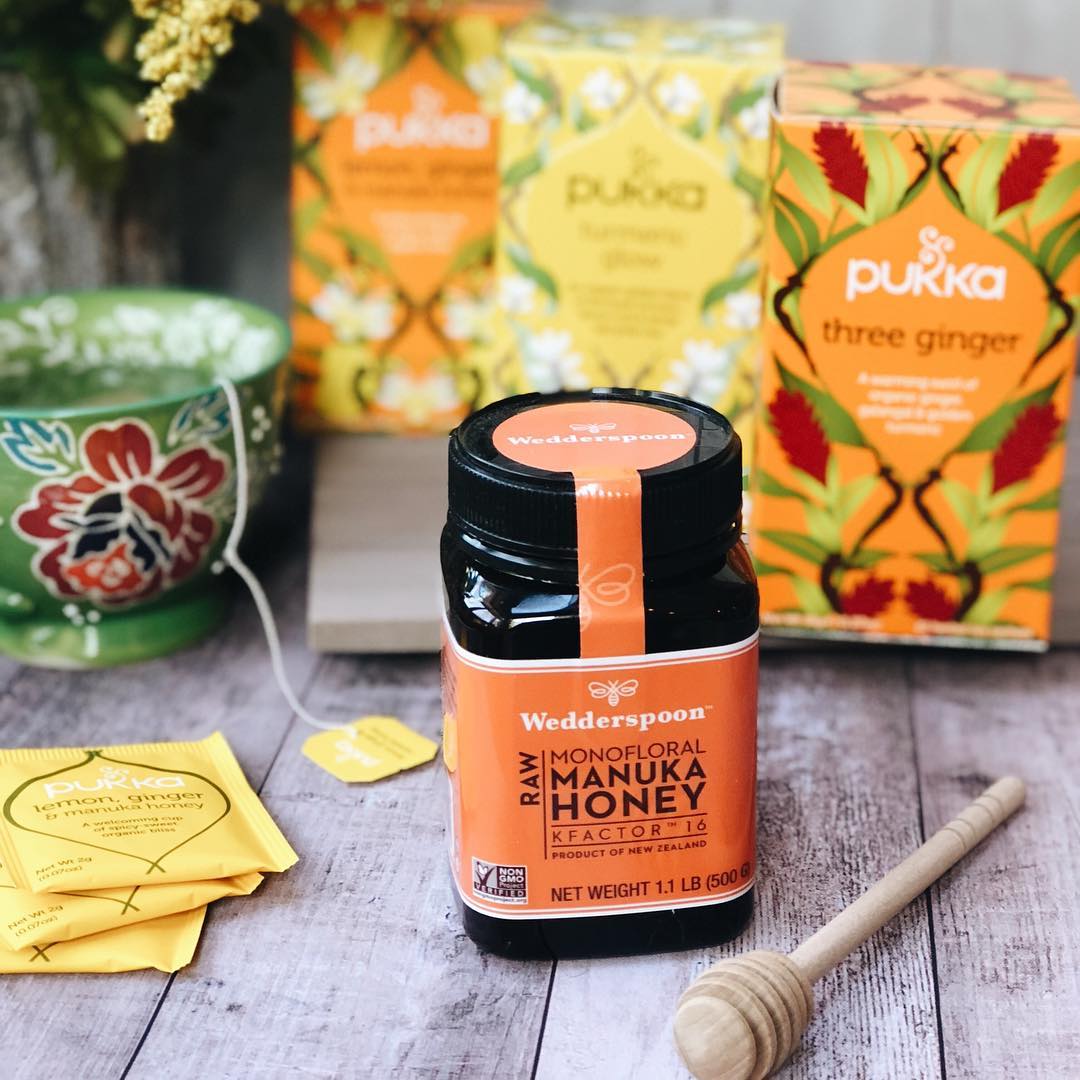As the days become cooler, we reach for our favorite all-natural immunity-boosting supplements: herbal teas and tinctures, zinc, fire cider, fresh citrus, and of course, honey. All year long, we favor local honey as our go-to all-purpose sweetener, but at this time of year, manuka honey reigns supreme. Manuka honey comes from bees that pollinate the flowering Manuka tree (Leptospermum scoparium). The shrub-like tree blooms for less than 20 days per year in New Zealand, and has been valued for centuries by the indigenous Māori people. Today, the manuka honey business helps to support the reawakening of their culture and economy. So what makes manuka honey so very special? Read on to find out!

Photo courtesy of Wedderspoon
A Lesson on Honey
Honey has been used as food and medicine throughout most of human history. According to Smithsonian Magazine, The earliest recorded use of honey for medicinal purposes comes from Sumerian clay tablets, which state that honey was used in 30 percent of prescriptions. The ancient Egyptians used medicinal honey regularly, making ointments to treat skin and eye diseases.
It is honey’s unique biochemical composition that makes it an excellent barrier against wounds, which is why it was historically used to cover skin ailments such as cuts, burns, and topical infections. So what is so magical about honey? Modern science tells us that it’s the fact that it contains hydrogen peroxide, which inhibits the growth of bacteria. And, because honey is thick, it creates a protective barrier. Hydrogen peroxide is an antiseptic that kills bacteria by destroying their cell walls. It is formed when bees add glucose oxidase (its stomach enzyme) to the nectar of a flower. As the glucose is broken down into honey, hydrogen peroxide is created.
Honey has also been praised as a natural cough suppressant, and promising studies show that it may reduce certain types of inflammation.

Photo credit: Flora
Honey as a Superfood
Honey contains over 200 natural amino acids, vitamins, minerals, and enzymes. The composition of different honeys is directly related to the unique blend of plants and botanicals that a bee collected pollen from throughout its life. (Fun fact: one bee will produce less than one tablespoon of honey in its lifetime.) The honey from the rare manuka flower is considered very special, for this reason.
Unique Properties of Manuka Honey
Manuka honey cannot be produced anywhere else in the world other than New Zealand, where the manuka tree blooms for just 20 days per year. And while all honey has hydrogen peroxide in it, manuka honey contains a naturally-occurring compound called methylglyoxal (MGO) which has special bacteria-fighting properties. The concentration of MGO in manuka honey is up to 100-fold higher than in other honey. It’s for this reason that we reach for manuka honey as part of our immunity-boosting routine!

Flower of the Manuka Tree, Photo credit: Avenue
Real Manuka
Like other sought-after commodities, such as olive oil, manuka honey fraud is a problem. Due to the very short and remote nature of harvest for manuka honey, it is an expensive product, and dishonest companies have tried to take advantage of consumers by selling a lesser, “watered down” product. We work with companies who use third-party certifiers to ensure that their honey is traceable, and actually contains the MGO levels promised on the jar.
In 2018, the New Zealand government created the first global standard and scientific definition for Manuka Honey, which you can view here. It defines two levels of manuka honey: multifloral and monofloral. The first describes a honey blend that is in part from the manuka plant, while the latter describes honey that is “wholly or mostly” from the manuka plant. (Because bees need variety in their diet, honey is never 100% from one nectar source.) All manuka honey exported from New Zealand must meet the MPI Manuka Honey Standard before it can be lawfully labeled as manuka.
While the MPI standard is the only government-regulated standard, other companies may also set their own standards for quality and labeling. For example, Wedderspoon uses something called the KFactor™ methodology, which focuses on five “key factors”. Their KFactor 16 honey would be considered “monofloral” while their KFactor 12 honey would be considered “multifloral”. Wedderspoon products also proudly bear the Fernmark label, which designates them as an ambassador of the New Zealand Story.
Flora, on the other hand, uses the UMF™ rating system, which means that it is licensed by the Unique Mānuka Factor Honey Association™ in New Zealand. Their products have been tested for the three signature compounds that ensure the honey is real manuka honey: Leptosperin, DHA (Dihydroxyacetone), and Methylglyoxal (MGO). The higher the UMF™ grading number on the product, the higher the concentration of signature compounds found in manuka honey. See the rating comparison chart below to see how the UMF™ rating relates to MGO content.

Photo courtesy of Flora
How to Enjoy Manuka Honey
Unpasteurized, raw manuka honey is delicious spread on toast, added to tea or smoothies, or eaten straight off a spoon. You can also incorporate it into your skincare routine, like these DIY Face Masks. How do you enjoy manuka honey? Let us know in the comments below!
Look to our stores for Manuka MGO 100+/5+ and Manuka MGO 400+/12+ from Flora brand as well as Manuka K-Factor 12+ and Manuka K-Factor 16+ from Wedderspoon, based in Malvern, PA.





